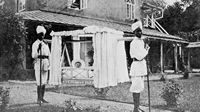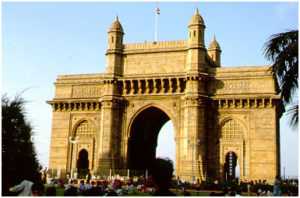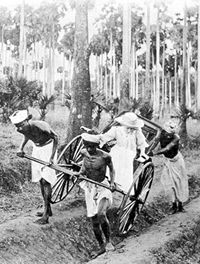See also [Mahatma Gandhi] [Quit India Movement] [Dandi March] [Hill Stations]
See additional papers and references at the end of this page
The British presence in India dates back to the early part of the seventeenth century. On 31 December 1600, Elizabeth, then the monarch of the United Kingdom, acceded to the demand of a large body of merchants that a royal charter be given to a new trading company, “The Governor and Company of Merchants of London, Trading into the East-Indies.” Between 1601-13, merchants of the East India Company took twelve voyages to India, and in 1609 William Hawkins arrived at the court of Jahangir to seek permission to establish a British presence in India. Hawkins was rebuffed by Jahangir, but Sir Thomas Roe, who presented himself before the Mughal Emperor in 1617, was rather more successful. Two years later, Roe gained Jahangir’s permission to build a British factory in Surat, and in 1639, this was followed by the founding of Fort St. George (Madras). Despite some setbacks, such as the Company’s utter humiliation at the hands of the Mughal Emperor Aurangzeb, with whom the Company went to war between 1688-91, the Company never really looked back.
Gateway of India, Bombay
In 1757, on account of the British victory at Plassey, where a military force led by Robert Clive defeated the forces of the Nawab of Bengal, Siraj-ud-daulah, the East India Company found itself transformed from an association of traders to rulers exercising political sovereignty over a largely unknown land and people. Less than ten years later, in 1765, the Company acquired the Diwani of Bengal, or the right to collect revenues on behalf of the Mughal Emperor, in Bengal, Bihar, and Orissa. The consolidation of British rule after the initial military victories fell to Warren Hastings, who did much to dispense with the fiction that the Mughal Emperor was still the sovereign to whom the Company was responsible. Hastings also set about to make the British more acquainted with Indian history, culture, and social customs; but upon his return to England, he would be impeached for high crimes and misdemeanors. His numerous successors, though fired by the ambition to expand British territories in India, were also faced with the task of governance. British rule was justified, in part, by the claims that the Indians required to be civilized, and that British rule would introduce in place of Oriental despotism and anarchy a reliable system of justice, the rule of law, and the notion of ‘fair play’. Certain Indian social or religious practices that the British found to be abhorrent were outlawed, such as sati in 1829, and an ethic of ‘improvement’ was said to dictate British social policies. In the 1840s and 1850s, under the governal-generalship of Dalhousie and then Canning, more territories were absorbed into British India, either on the grounds that the native rulers were corrupt, inept, and notoriously indifferent about the welfare of their subjects, or that since the native ruler had failed to produce a biological male heir to the throne, the territory was bound to “lapse” into British India upon the death of the ruler. Such was the fate of Sambalpur (1849), Baghat (1850), Jhansi (1853), Nagpur (1854), and — most tragically — Awadh (1856). The Nawab of Awadh [also spelled as Oudh], Wajid Ali Shah, was especially reviled by the British as the worst specimen of the Oriental Despot, more interested in nautch girls, frivolous amusements — kite-flying, cock-fighting, and the like — and sheer indolence than in the difficult task of governance. The British annexation of Awadh, and the character of the Nawab, were made the subjects of an extraordinary film by Satyajit Ray, entitled The Chess Players (“Shatranj ke Khilari”).

An English baby girl being carried on a palanquin by Indian bearers, on the road fo Nainital. Photograph dated 1904.
Shortly after the annexation of Awadh, the Sepoy Mutiny, more appropriately described as the Indian Rebellion of 1857-58, broke out. This was by far the greatest threat posed to the British since the beginnings of their acquisition of an empire in India in 1757, and within the space of a few weeks in May large swathes of territory in the Gangetic plains had fallen to the rebels. Atrocities were committed on both sides, and conventionally the rebellion is viewed as marking the moment when the British would always understand themselves as besieged by hostile natives, just as the Indians understood that they could not forever be held in submission. If in the early days of the Company’s rule a legend was constructed around the Black Hole of Calcutta, so signifying the villainy of Indians, the Rebellion of 1857-58 gave rise to an elaborate mythography on both sides. Delhi was recaptured by British troops in late 1857, the Emperor Bahadur Shah, last of the Mughals, was put on trial for sedition and predictably convicted, and by mid-1858 the Rebellion had been entirely crushed. The East India Company was abolished, though John Stuart Mill, the Commissioner of Correspondence at India House, London, and the unacknowledged formulator of British policy with respect to the native states, furnished an elaborate but ultimately unsuccessful plea on behalf of the Company. India became a Crown colony, to be governed directly by Parliament, and henceforth responsibility for Indian affairs would fall upon a member of the British cabinet, the Secretary of State for India, while in India itself the man at the helm of affairs would continue to be the Governor-General, known otherwise in his capacity as the representative of the monarch as the Viceroy of India.
The proclamation of Queen Victoria, in which she promised that she and her officers would work for the welfare of their Indian subjects, ushered in the final phase of the British Raj. Among Indians, there were debates surrounding female education, widow remarriage, the age of consent for marriage, and more generally the status of women; and in the meanwhile, with increasing emphasis on English education, and the expansion of the government, larger numbers of Indians joined government service. There was, similarly, a considerable increase in both English-language and vernacular journalism, and in 1885 the Indian National Congress, at first an association comprised largely of lawyers and some other professionals, was founded in order that educated Indians might gain something of a voice in the governance of their own country. However, nationalist sentiments could not be confined within the parameters set by a gentlemanly organization such as the Congress, and both in Maharashtra, where the radicals were led by Bal Gangadhar Tilak, and in Bengal armed revolutionaries attempted to carry out a campaign of terror and assassination directed at British officials and institutions. In 1905, on the grounds that the governance of Bengal had become impossible owing to the large size of the presidency, the British partitioned Bengal, and so provoked the first major resistance to British rule and administrative policies in the aftermath of the Rebellion of 1857-58. It is during the Swadeshi movement that Indians deployed various strategies of non-violent resistance, boycott, strike and non-cooperation, and eventually the British had to agree to revoke the partition of Bengal. The partition itself had been attempted partly with a view to dividing the largely Muslim area of East Bengal from the western part of Bengal, which was predominantly Hindu, and the communalist designs of the British were clearly demonstrated as well in their encouragement of the Muslim League, a political formation that came into existence in 1907, on the supposition that the interests of the Muslims could not be served by the Indian National Congress. The capital of the country was shifted as well from Calcutta to Delhi, where a new set of official buildings designed to reflect imperial splendor led to the creation of New Delhi.
During World War I, when Britain declared that India was at war with Germany as well, large number of Indian troops served overseas, and the declaration by the Secretary of State Montagu in 1917 to the effect that it would be the intent of the Government of India to increase gradually Indian participation in the administration of the country was seen as an encouragement of Indian ambitions of eventual self-rule. But following the conclusion of the war, the British sought to introduce draconian legislation to contain the activity of people presumed to be political extremists, and the Punjab disturbances of 1919, including the notorious massacre by General Dyer of nearly 400 unarmed Indians at the Jallianwala Bagh in Amritsar in April, marked the emergence of a nation-wide movement against British rule. The events of 1919 also brought to the fore Mahatma Gandhi, who would henceforth be the uncrowned king of the Indian nationalist movement. Gandhi led the non-cooperation movement against the British in 1920-22, as well as a campaign of civil disobedience in 1930-31, and in 1942 he issued the call to the British to ‘Quit India‘. Negotiations for some degree of Indian independence, led by Gandhi, first took place in 1930 at the Round Table Conferences in London, but shortly thereafter the Congress decided to adopt a resolution calling for purna swaraj, or complete independence from British rule. Meanwhile, relations between the Hindus and Muslims had deteriorated, and during the latter years of World War II, when the leaders of the Congress, including Gandhi, Jawaharlal Nehru, and Sardar Patel were incarcerated, the Muslim League, which declared itself in support of the British war effort, had a free hand to spread the message of Muslim separatism. When, in the aftermath of the war, and the triumph of the Labor party, the British Prime Minister Clement Atlee declared that the British would grant India its independence, negotiations were commenced with all the major political parties and communities, including the Sikhs, the Congress, and the Muslim League. In launching Direct Action Day in 1946, which led to immense communal killings in Calcutta, the Muslim League sought to convey the idea that an undivided India was no longer a possibility; and the eventual attainment of independence from British rule on 15 August 1947 was accompanied not only by the creation of the new state of Pakistan, comprised of Muslim-majority areas in both the eastern and western parts of India, but by the unprecedented horrors of partition. At least 500,000 people are estimated to have been killed, and many women were abducted or raped; and it is estimated that no fewer than 11 million Hindus, Muslims, and Sikhs crossed borders, which to this day remains the single largest episode of migration in history.
Though the political narrative dominates in accounts of the history of British India, as in the preceding pages, the social and cultural histories of the British Raj are no less interesting. There are doubtless enduring, though not necessarily desirable, influences of British rule in contemporary India. The elites of the country write and converse largely in English, and are connected amongst themselves, and to the larger world outside, through the English language. The Constitution of India, howsoever noble a document, has been decisively shaped by the Government of India Act of 1935, which was scarcely designed to alleviate the distress of the predominantly underprivileged population of India, and not much thought seems to have been given to considering how appropriate a parliamentary system, with roughly the same number of seats in the lower (elected) house, the Lok Sabha, as in the House of Commons, might be for India when it is infinitely larger than Britain. The political and administrative institutions of independent India operate on the assumption that the country is still under colonial rule, and that the subjects are to have no voice in governance, unless they make an extreme fuss. The legal structure was handed down by the British, and the presumption remains that it does not exist to serve the common person, any more than does the vast apparatus of ‘law and order’: it is no accident that the police always arrive late in the popular Hindi film, when communities have already successfully taken the law into their own hands. The only innovations which have of been use in meeting forms of extreme oppression and injustice, such as Public Interest Litigation, are those which have effected a departure from the colonial model of justice.
India inherited from the British its present university system, and the origins of the summer migration of the middle class and elites to hill stations date back to the early nineteenth century. Social institutions such as clubs and gymkhanas, which persist down to the present day, were a critical part of British life, as E. M. Forster’s A Passage to India, Orwell’s Burmese Days, and the novels of John Masters and Paul Scott so amply suggest. Though the Indian languages were well developed before the arrival of the British in India, the standardization of these languages, and the creation of the first grammars and dictionaries, was achieved under British rule. The influential school of Kalighat painting emerged in late nineteenth century, and can scarcely be understood without a reference to the creation of a modern market, and similarly the printing press, which arrived in India in the sixteenth century, heralded the age of mechanical reproduction in India. In sports, the abiding passion remains cricket (once a preeminently colonial game), and the favorite drink of the Indian middle class male remains scotch and soda. One could point to a thousand different manifestations of the British presence in India, and slowly, one hopes, our histories will also alert us to the transformations wrought in British institutions and practices in post-independent India.
Other related publications on the history of British India by Vinay Lal:
“The Saga of Subhas Bose“, review of Leonard Gordon’s Brothers Against the Raj, Economic and Political Weekly 27, no. 4 (25 January 1992):155-156.
“The Incident of the Crawling Lane: Women in the Punjab Disturbances of 1919“, Genders, no. 16 (Spring 1993):35-60.
“Surat Under the Raj“, review of Douglas Haynes, Rhetoric and Ritual in Colonial India, Economic and Political Weekly 28, no. 18 (1 May 1993):863-865.
“Imperial Nostalgia“, review of The Raj: India and the British 1600-1947, by C. A. Bayly et al., Economic and Political Weekly 28, nos. 29-30 (17-24 July 1993):1511-13.
“Beyond Alterity”, review of Sara Suleri’s The Rhetoric of English India, Economic and Political Weekly 30, no. 5 (4 February 1995):254-55.
“The Courtesan and the Indian Novel“, a review-article on Hasan Shah, The Nautch Girl, and Mirza M. H. Ruswa, Umra Jan Ada, Courtesan of Lucknow, Indian Literature, no. 139 (Sept-Oct 1995):164-70.
“Masculinity and Femininity in The Chess Players: Sexual Moves, Colonial Manoeuvres, and an Indian Game“, in Manushi: A Journal of Women and Society, nos. 92-93 (Jan.-April 1996):41-50.
“Good Nazis and just scholars: much ado about the British Empire“, review of P. J. Marshall, ed., Cambridge Illustrated History of the British Empire, Race and Class 38, no. 4 (April-June 1997):89-101.
“Hill Stations: Pinnacles of the Raj.” Review article on Dale Kennedy, The Magic Mountains: Hill Stations and the British Raj, Capitalism, Nature, Socialism 8, no. 3 (September 1997):123-132.
“John Stuart Mill and India“, a review-article. New Quest, no. 54 (January-February 1998):54-64.
“Everyday Crime, Native Mendacity and the Cultural Psychology of Justice in Colonial India.” Studies in History (New Series) 15, no. 1 (1999):145-66.
“Walking with the Subalterns, Riding with the Academy: The Curious
Ascendancy of Indian History“, Studies in History (New Series) 17, no. 1
(2001), pp. 101-133.
“Subaltern Studies and Its Critics: Debates over Indian History“,
History and Theory 40, no. 1 (February 2001), pp. 135-48.
“Reading between the Frames: The Burden and Freedom of
Photography“, Economic and Political Weekly 35, no. 14 (1 April 2000),
pp. 1167-1170.
“Anti-terrorist Legislation: A Comparative Study of India, UK and Sri Lanka”,
Lokayan Bulletin 11, no. 1 (July-August 1994), pp. 5-24.
Review of Dipesh Chakrabarty, Habitations of Modernity (2002), in Journal of Interdisciplinary History 35, no. 2 (Autumn 2004):343-45.
Review of Antoinette Burton, Dwelling in the Archive (2002), in Biography: An Interdisciplinary Quarterly 27, no. 3 (Summer 2004):673-676.
Review of Michael Gottlob, Historical Thinking in South Asia (2003), in Indian Economic and Social History Review 41, no. 4 (2004), pp. 501-4.
“Mapping India”, review of J. B. Harley and David Woodward, eds., Cartography in the Traditional Islamic and South Asian Societies, The Book Review 17, no. 9 (Sept. 1993):8-9.




